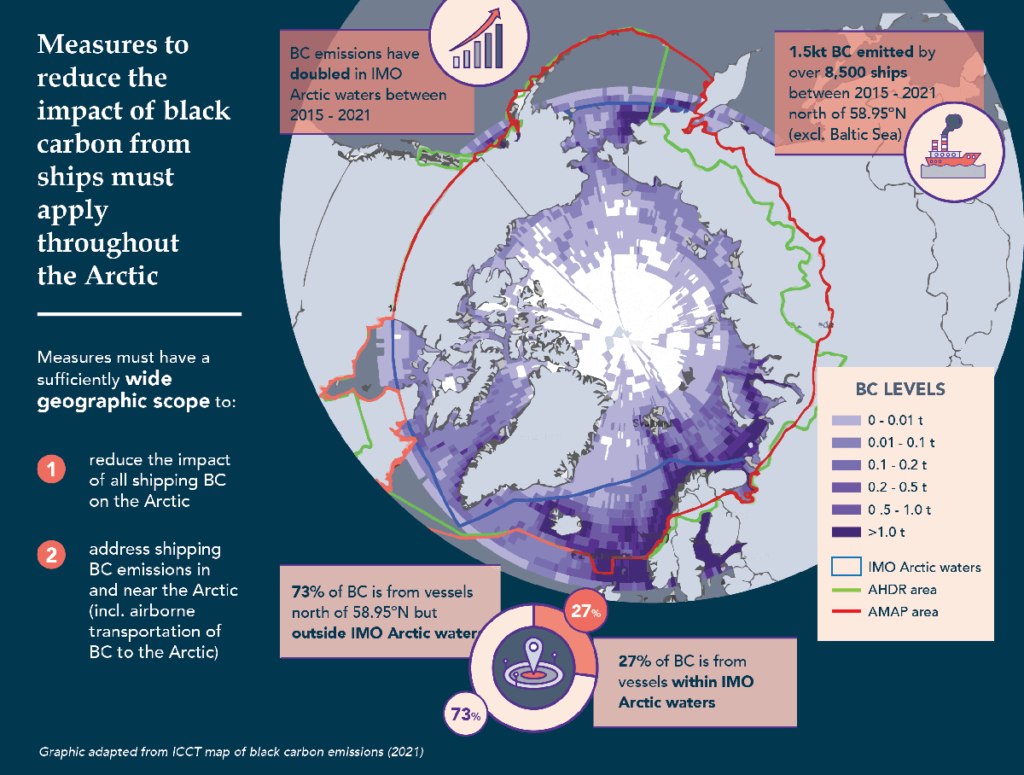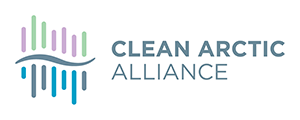
31 January, 2025: – As a meeting of the International Maritime Organization’s (IMO) Pollution Prevention and Response sub-committee (PPR 12) closes today in London, the Clean Arctic Alliance welcomed the broad support from IMO member states, and parts of the fuel and shipping industry, for the development of a polar fuels definition, but called on shipping nations to urgently move forward on regulating such fuels to reduce the impact of black carbon – a potent short-lived climate pollutant – on the Arctic.
The Alliance also expressed its disappointment over the lack of progress on banning scrubbers – exhaust gas cleaning systems that remove harmful pollutants and particulate matter from exhaust emissions, meaning the pollutants are dumped into the ocean, rather than the atmosphere.
“While the Clean Arctic Alliance welcomes the steps taken by IMO member states this week in supporting the development of the concept of polar fuels – cleaner fuels, with lower black carbon emissions, appropriate for use in the Arctic – there was as yet no commitment to regulate for the use of these fuels in order to reduce emissions of black carbon in the Arctic”, said Dr Sian Prior, Lead Advisor to the Clean Arctic Alliance.
“IMO Member States must now urgently commit to the development of a new regulation in MARPOL Annex VI – the international convention which regulates discharges and emissions from ships – ahead of their next meeting (PPR13, likely in 2026), in order to address one of the longest running issues on the IMO’s agenda – reducing the impact of black carbon emissions on the Arctic”, said Prior. “This new rule must mean that only polar fuels – once defined – can be used in and near to the Arctic.”
“With the Arctic warming four times faster than the rest of the planet, and rapidly approaching the point where changes such as the loss of sea ice, melting of the Greenland ice sheet, and slowing down of ocean circulation patterns drives further warming, it is a travesty that the IMO and its member states allow the shipping industry to continue increasing emissions of black carbon”, added Prior. “While shipping emissions in and near the Arctic continue to rise, other sectors, such as land-based diesel-powered engines, oil and gas operations and agriculture, are actively reducing their emissions of black carbon.”
Polar Fuels
“The good news is that this week, the marine fuel industry has demonstrated to PPR 12 the fuel quality characteristics of distillate grade DMA fuels which should replace residual fuels in the Arctic and lower ship black carbon emissions”, said Bill Hemmings, Black Carbon Advisor to the Clean Arctic Alliance. “These characteristics could form the basis of a new mandatory IMO regulation. Furthermore it was made clear that these fuels – dubbed ‘polar fuels’ – are both readily and widely available globally and far easier to clean up if spilt than residual fuels. This is a significant step forwards to a definition of DMA polar fuels, which along with low or zero carbon fuels being developed to reduce ship GHG emissions, can finally lead to real cuts in shipping’s climate impacts on the Arctic.”
Scrubbers
“The Clean Arctic Alliance is disappointed that there still remains a lack of consensus amongst IMO member states around banning scrubbers globally or even regulating discharges from scrubbers, despite mounting evidence of environmental impacts”, said Eelco Leemans, Technical Advisor to the Clean Arctic Alliance. “Currently there are no global restrictions on scrubbers discharges even in protected areas, but with growing domestic regulation in countries such as Denmark, Sweden and Finland, the shipping sector faces a growing patchwork of national regulation, resulting in different standards being applied around the world. IMO member states must commit to mandatory regulation at PPR 13 in 2026 starting with the adoption of a resolution that will call on shipping operators to immediately stop the release of scrubber discharge wastes in marine protected areas, habitats important for endangered wildlife, and other ecologically sensitive areas such as the Arctic.”
See also:
- On January 28, Sweden’s government banned discharges from scrubbers into Swedish waters
- Steering Away From Scrubbers – Eelco Leemans, Clean Arctic Alliance
Relevant IMO Papers on scrubbers:
- PPR 12/INF.15: Air quality and health impacts of using EGCS (scrubbers) in Canadian waters
- MEPC 82/5: Legal analysis on exhaust gas cleaning systems as an alternative compliance mechanism under MARPOL Annex VI from an air quality impact perspective
- MEPC 82/5/2*: Regulating Black Carbon emissions from international shipping impacting the Arctic
- MEPC 82/5/4: Air Pollution Prevention: EGCS pollution in Pacific Canada: investigation of Canada
- MEPC 81/5/4: Regulation 4.1 of MARPOL Annex VI must not be interpreted in isolation of other regulations, resolutions and obligations
About Black Carbon and the Arctic
In a paper submitted to the IMO’s Marine Environment Protection Committee in 2024, (MEPC 82/5/2*: Regulating Black Carbon emissions from international shipping impacting the Arctic) NGOs called on IMO Member States to consider the development of a new regulation for inclusion in MARPOL Annex VI (the main international treaty addressing air pollution prevention requirements from ships) which would identify suitable polar fuels, for example distillate fuels, such DMA or DMZ, to deliver an immediate fuel-based reduction in black carbon emissions from international shipping impacting the Arctic. The paper develops the concept of “polar fuels” discussed previously at PPR 11 and sets out the fuel characteristics that would distinguish polar fuels from residual fuels and thus lead to fuel-based reductions in ship Black Carbon emissions if mandated for use in and near the Arctic.
Black carbon is a short-lived climate pollutant, produced by the incomplete burning of fossil fuels, with an impact more than three thousand times that of CO2 over a 20 year period. It makes up around one-fifth of international shipping’s climate impact. Not only does it contribute to warming while in the atmosphere, black carbon accelerates melting if deposited onto snow and ice – hence it has a disproportionate impact when released in and near to the Arctic. The melting snow and ice exposes darker areas of land and water and these dark patches then absorb further heat from the sun and the reflective capacity of the planet’s polar ice caps is severely reduced. More heat in the polar systems – results in increased melting. This is the loss of the albedo effect. Recently in its 6th Assessment Report, the UN Intergovernmental Panel on Climate Change (IPCC) doubled the estimate of the warming potential of black carbon on snow and ice due to a better understanding of its warming impact.
Declines in sea ice extent and volume are leading to a burgeoning social and environmental crisis in the Arctic, while cascading changes are impacting global climate and ocean circulation. Scientists have high confidence that processes are nearing points beyond which rapid and irreversible changes on the scale of multiple human generations are possible. Scientists say it is now too late to save summer Arctic sea ice, and research has shown that “preparations need to be made for the increased extreme weather across the northern hemisphere that is likely to occur as a result.”
Black carbon also has a negative impact on human health, and recent research has found black carbon particles in the body tissues of foetuses, following inhalation by pregnant mothers.
The need to reduce emissions of black carbon because of both the climate and health impacts has been long recognised. On land, considerable effort has been made to ban dirtier fuels in power stations, to install diesel particulate filters on land-based transport, and to improve the burning of dry wood – all to reduce emissions of black carbon and improve air quality. However, at sea the same efforts have not yet been made.
January 24 press release:PPR 12 – Shipping Nations Must Switch to Cleaner Fuels To Cut Black Carbon
Find out more about black carbon
Relevant IMO Papers on black carbon:
- PPR 12-6: Polar fuels
- PPR 12/6/1: Reduction of the Impact on the Arctic of Black Carbon Emissions From International Shipping
- PPR 12/6/2: Reduction of the Impact on the Arctic of Black Carbon Emissions From International Shipping- Arctic Climate Crisis
- PPR 12/5: Comments on documents MEPC 78/14/1 and PPR 10/10/1, and a possible definition of “polar oil fuels”
- MEPC 82/5/2*: Regulating Black Carbon emissions from international shipping impacting the Arctic
Recent articles and press releases:
- Reducing Black Carbon in the Arctic – Bill Hemmings, Clean Arctic Alliance
- An IMO Commitment to Polar Fuels Could Cut Black Carbon Emissions – Bill Hemmings, Clean Arctic Alliance
Further reading:
WWF, The Circle: Navigating a Changing Arctic:
- Arctic Shipping Must Change – Elena Tracy, WWF
- Steering Away From Scrubbers – Eelco Leemans, Clean Arctic Alliance
- Reducing Black Carbon in the Arctic – Bill Hemmings, Clean Arctic Alliance
- International Governance, Regional Collaboration — and More Ambition All Round – Sam Davin, WWF
- Will the IMO Tighten the Rules Around Carbon Emissions? – John Maggs, Clean Shipping Coalition
Other:
- Clean Arctic Alliance Vision for Greenland, Faroe Islands, and Denmark Chairship of the Arctic Council
- High North News: Targeting Black Carbon and Methane at the Arctic Council (Sian Prior and Andrew Dumbrille)
- Tradewinds: There’s a simple fix for the Arctic’s climate crisis — use cleaner shipping fuels (Kay Brown, Pacific Environment)
ENDS
Contact:
Dave Walsh, Communications Advisor, [email protected], +34 691 826 764
About the Clean Arctic Alliance
Made up of 24 not-for-profit organisations, the Clean Arctic Alliance campaigns to persuade governments to take action to protect the Arctic, its wildlife and its people.
Members include: Alaska Wilderness League, Bellona, Clean Air Task Force, Ecology and Development Foundation ECODES, Environmental Investigation Agency, Equal Routes, Eurasian Wildlife and Peoples, Friends of the Earth US, Global Choices, Green Global Future, Green Transition Denmark, Greenpeace, Iceland Nature Conservation Association, International Cryosphere Climate Initiative, Nature And Biodiversity Conservation Union, 90 North Foundation, Ocean Conservancy, Pacific Environment, Seas At Risk, Surfrider Foundation Europe, Stand.Earth, Transport & Environment, WWF and Zero.
More more information visit https://www.cleanarctic.org/

